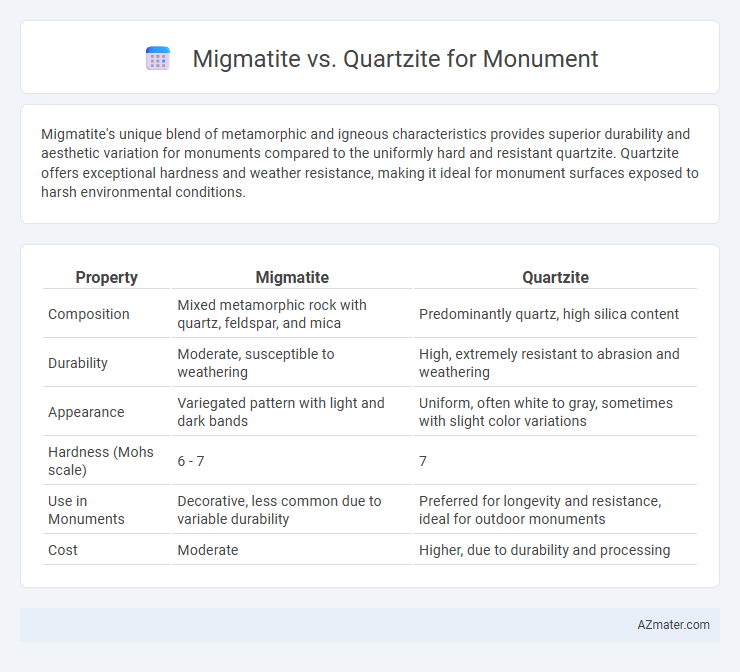Migmatite's unique blend of metamorphic and igneous characteristics provides superior durability and aesthetic variation for monuments compared to the uniformly hard and resistant quartzite. Quartzite offers exceptional hardness and weather resistance, making it ideal for monument surfaces exposed to harsh environmental conditions.
Table of Comparison
| Property | Migmatite | Quartzite |
|---|---|---|
| Composition | Mixed metamorphic rock with quartz, feldspar, and mica | Predominantly quartz, high silica content |
| Durability | Moderate, susceptible to weathering | High, extremely resistant to abrasion and weathering |
| Appearance | Variegated pattern with light and dark bands | Uniform, often white to gray, sometimes with slight color variations |
| Hardness (Mohs scale) | 6 - 7 | 7 |
| Use in Monuments | Decorative, less common due to variable durability | Preferred for longevity and resistance, ideal for outdoor monuments |
| Cost | Moderate | Higher, due to durability and processing |
Introduction to Migmatite and Quartzite
Migmatite is a metamorphic rock characterized by a mixture of igneous and metamorphic features, often displaying a banded or swirled appearance due to partial melting. Quartzite is a hard, non-foliated metamorphic rock formed from pure quartz sandstone, known for its durability and resistance to weathering. Both rocks are valued for monuments, with migmatite offering unique aesthetic patterns and quartzite providing exceptional hardness and longevity.
Geological Formation of Migmatite and Quartzite
Migmatite forms through the partial melting of pre-existing metamorphic rocks under extreme temperature and pressure conditions, resulting in a composite rock with both igneous and metamorphic characteristics. Quartzite originates from the metamorphism of pure quartz sandstone subjected to intense heat and pressure, causing recrystallization of quartz grains into an interlocking mosaic. These distinct geological formations influence their durability and aesthetic appeal in monument applications.
Physical Properties Comparison
Migmatite features a heterogeneous texture with alternating layers of metamorphic and igneous minerals, providing moderate hardness around 6-7 on the Mohs scale and good durability. Quartzite, composed primarily of recrystallized quartz, exhibits superior hardness of 7-8 and exceptional resistance to weathering, making it highly suitable for monumental structures. Both stones offer substantial strength, but quartzite's higher density and low porosity enhance its long-term performance for outdoor monuments.
Aesthetic Differences in Monuments
Migmatite offers a visually complex blend of light and dark mineral bands, creating a striking marbled pattern that enhances the uniqueness of monuments. Quartzite is characterized by a more uniform, crystalline texture with a range of soft to vibrant colors, providing a sleek and polished appearance for monumental structures. The intricate veining in migmatite appeals to those seeking dramatic aesthetics, while quartzite's consistent grain suits designs prioritizing elegance and refined simplicity.
Durability and Weather Resistance
Migmatite exhibits superior durability and weather resistance for monuments due to its complex interlayered structure of metamorphic and igneous components, which enhances its strength and reduces susceptibility to erosion. Quartzite, composed primarily of fused quartz grains, offers excellent hardness and resistance to chemical weathering but may be more prone to fracturing under mechanical stress. Both materials provide robust options for outdoor monuments, but migmatite's composite nature generally affords longer-lasting performance in harsh environmental conditions.
Ease of Carving and Shaping
Migmatite offers moderate ease of carving and shaping due to its mixed metamorphic composition, balancing hardness with workable layers, making it suitable for detailed monument work. Quartzite, known for its extreme hardness and durability, presents significant challenges in carving and shaping, often requiring specialized tools and techniques. For monuments demanding precision and intricate designs, migmatite is generally preferred over quartzite because it allows more manageable sculpting without compromising structural integrity.
Cost and Availability
Migmatite tends to be more expensive than quartzite due to its complex formation and relative rarity, making it less available for large-scale monument projects. Quartzite is widely available and generally more affordable, offering durability and a consistent appearance that suits monumental applications. Cost-efficiency and ease of sourcing quartzite often make it the preferred choice for budget-conscious monument construction.
Historical Use in Monument Construction
Migmatite and quartzite exhibit distinct historical significance in monument construction, with quartzite being extensively favored for its exceptional hardness and weather resistance, notably used in ancient Egyptian temples and Indian stupas. Migmatite, while less commonly employed, appears in some Neolithic stone structures where its mixed metamorphic texture provided both aesthetic appeal and structural integrity. The durability and visual complexity of quartzite have driven its preference in iconic monuments, whereas migmatite's role is more localized and linked to regions with specific geological availability.
Maintenance and Longevity
Migmatite offers superior durability with its interleaved metamorphic and igneous layers, making it highly resistant to weathering and ideal for long-lasting monuments requiring minimal maintenance. Quartzite, composed primarily of quartz, provides exceptional hardness and scratch resistance but may need more frequent sealing to prevent surface degradation in harsh environments. Both stones ensure longevity, but migmatite's complex structure often demands less upkeep, preserving monument aesthetics over time with greater resilience.
Choosing the Right Stone for Monuments
Migmatite offers a unique blend of metamorphic and igneous textures, providing both visual complexity and durability, ideal for monuments exposed to varied weather conditions. Quartzite, known for its hardness and resistance to erosion, ensures longevity and minimal maintenance in outdoor memorials. Selecting between migmatite and quartzite depends on the desired aesthetic, durability requirements, and environmental factors at the monument site.

Infographic: Migmatite vs Quartzite for Monument
 azmater.com
azmater.com